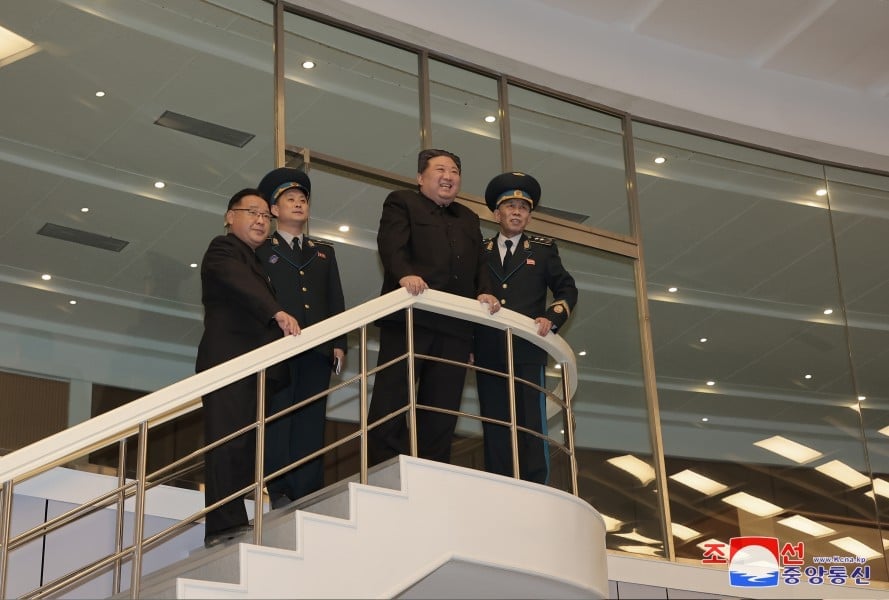
KCNA Photo
North Korea launched a military satellite Tuesday night, in violation of U.N. Security Council resolutions, prompting condemnations from various countries.
The Republic of Korea (ROK) suspended portions of a 2018 military agreement between the two countries that was designed to lessen the chance of confrontation while ROK defense minister Shin Won-Sik called for drills between the U.S., Korea and Japan in light of the presence of carrier USS Carl Vinson (CVN-70) in the ROK to demonstrate resolve against North Korea..
North Korea’s state-run Korea Central News Agency (KCNA) reported Tuesday that the “Chollima-1″ rocket carrying reconnaissance satellite “Malligyong-1” was launched at the Sohae Satellite Launching Ground in Cholsan County, North Phyongan Province, at 10:42 p.m. on Tuesday. KCNA also reported that North Korean leader Kim Jong Un was present at the launch site to oversee the launch.
Kim Jong Un visited the Pyongyang General Control Center of the National Aerospace Technology Administration Wednesday and saw pictures of Anderson Air Force Base, Apra Harbor and other major U.S military bases on Guam taken by the reconnaissance satellite, KCNA reported.
The U.S, ROK and Japan all confirmed the launch but none of the countries would confirm that the satellite was successfully placed into orbit,
“We are aware of the DPRK’s launch of a space launch vehicle and are consulting with the ROK and Japan, as well as other regional allies and partners. So I can confirm that we are aware of that but we’re still assessing the success of the launch,” Deputy Pentagon Press Secretary Sabrina Singh said in a Tuesday briefing.
Japan’s Ministry of Defense stated that the rocket separated into two parts, the first part falling into the East China Sea at 10:50 p.m. in an area 217 miles west of the Korean Peninsula and the second one passing over the skies between Okinawa and Miyako Island at 10:55 p.m. before landing in the Philippine Sea at 10:57 p.m. in a location 745 miles southwest of Okinotori Island. Both parts fell outside Japan’s Exclusive Economic Zone. The statement also said that further details are being analyzed, but no satellite has been confirmed to have entered orbit at the time.
North Korea’s launch came ahead of its declared launch window of Dec. 1 and was condemned by various nations and organizations. The United Nations issued a statement saying that U.N. Secretary-General António Guterres condemned the launch by North Korea of yet another military satellite using ballistic missile technology and that any launch by North Korea using ballistic missile technology is contrary to the relevant Security Council resolutions.
The Pentagon issued a release on Tuesday saying that Assistant Secretary of Defense for Indo-Pacific Security Affairs Ely Ratner spoke in separate calls that day with ROK Deputy Minister for National Defense Policy Heo Taekeun and with Japan Director-General for Defense Policy Kano Koji.
U.S. officials strongly condemned North Korea’s Nov. 21 attempted space launch using ballistic missile technology as a violation of multiple U.N. Security Council resolutions, according to the release. Ratner reaffirmed the ironclad U.S. extended deterrence commitment to the defense of the ROK and Japan in the release.
The ROK government suspended Article 1, Paragraph 3 of the “September 19 Military Agreement” Wednesday, and aerial reconnaissance and surveillance along the demarcation line will be restored, according to an ROK Defense Ministry release. North Korea had been informed of the suspension.
ROK Defense Minister Shin Won-Sik visited Carl Vinson, which docked in Busan for a port visit on Wednesday. During his visit, he requested bilateral drills between the U.S. and ROK and trilateral drills between the two countries and Japan to be planned “so that we can be fully prepared to immediately respond to any form of provocation by North Korea and demonstrate ROK-U.S. strong will to respond,” according to a ROK MND release.
The U.S., ROK and Japan have previously responded with various bilateral and trilateral deterrent drills when North Korea conducts ballistic missile launches. The drills are typically joint flights with U.S. Air Force bombers from the Bomber Task Force deployed in the Indo-Pacific and with Aegis destroyers from all three countries tasked with ballistic missile surveillance and defense.
The ROK’s Joint Chiefs of Staff (JCS), in a message distributed to the media, said that the ROK, the U.S. and Japan deployed Aegis destroyers near the planned flight path in advance to jointly detect and track the North’s satellite and shared relevant information shortly after the launch.
A Royal Australian Navy (RAN) Aegis destroyer is also present around Japan.
HMAS Brisbane (DDG-41), together with fleet oiler HMAS Stalwart (A-304), took part in the Japan Maritime Self Defense Force (JMSDF) Annual Exercise, which concluded on Monday.
Brisbane is on the south side of Japan in the Philippine Sea and Pacific Ocean waters of the country. Brisbane, Stalwart and a Royal Australian Air Force (RAAF) P-8 Poseidon Maritime Patrol Aircraft (MPA) carried out the Japan-Australia Trident 23-2 bilateral exercise with destroyer JS Sazanami (DD-113) and a JMSDF submarine along with a JMSDF P-1 MPA on Monday and Tuesday. The drills involved various tactical exercises, according to a JMSDF release.
On Wednesday, RAN frigate HMAS Toowoomba (FFH-156) carried out the Trident 23-3 exercise with a JMSDF P-3C Orion MPA in the East China Sea, according to a JMSDF release.
All three RAN ships set out in September for a three-month regional presence deployment to Southeast and Northeast Asia, which will conclude in December.





